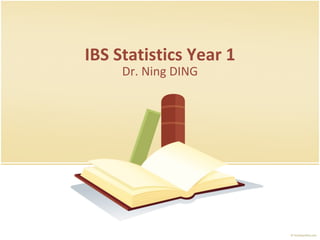
IBS Statistics Year 1 Excel Descriptive Analysis
- 1. IBS Statistics Year 1 Dr. Ning DING
- 3. Tip 1: Automatic numbering Excel Practices
- 4. Tip 2: Sum up the values Excel Practices
- 5. Tip 3: Ranking the data Excel Practices
- 6. Tip 4: Calculation Excel Practices
- 7. Question 1: Descriptive Analyses Excel Practices
- 8. Question 1: Descriptive Analyses Excel Practices
Hinweis der Redaktion
- The scatter diagram is another visual display of data. It shows the association between two variables acting continuously on the same item. The scatter diagram illustrates the strength of the correlation between the variables through the slope of a line. This correlation can point to, but does not prove, a causal relationship. Therefore, it is important not to rush to conclusions about the relationship between variables as there may be another variable that modifies the relationship. For example, analyzing a scatter diagram of the relationship between weight and height would lead one to believe that the two variables are related. This relationship, however, does not mean causality; for instance, while growing taller may cause one to weigh more, gaining weight does not necessarily indicate that one is growing taller. The scatter diagram is easy to use, but should be interpreted with caution as the scale may be too small to see the relationship between variables, or confounding factors may be involved. Scatter diagrams make the relationship between two continuous variables stand out visually on the page in a way that the raw data cannot. Scatter diagrams may be used in examining a cause-and-effect relationship between variable data (continuous measurement data). They can also show relationships between two effects to see if they might stem from a common cause or serve as surrogates for each other. They can also be used to examine the relationship between two causes. How to Use It Scatter diagrams are easy to construct. Step 1. Collect at least 40 paired data points: "paired" data are measures of both the cause being tested and its supposed effect at one point in time. Step 2. Draw a grid, with the "cause" on the horizontal axis and the "effect" on the vertical axis. Step 3. Determine the lowest and highest value of each variable and mark the axes accordingly. Step 4. Plot the paired points on the diagram. If there are multiple pairs with the same value, draw as many circles around the point as there are additional pairs with those same values. Step 5. Identify and classify the pattern of association using the graphs below of possible shapes and interpretations.
- The scatter diagram is another visual display of data. It shows the association between two variables acting continuously on the same item. The scatter diagram illustrates the strength of the correlation between the variables through the slope of a line. This correlation can point to, but does not prove, a causal relationship. Therefore, it is important not to rush to conclusions about the relationship between variables as there may be another variable that modifies the relationship. For example, analyzing a scatter diagram of the relationship between weight and height would lead one to believe that the two variables are related. This relationship, however, does not mean causality; for instance, while growing taller may cause one to weigh more, gaining weight does not necessarily indicate that one is growing taller. The scatter diagram is easy to use, but should be interpreted with caution as the scale may be too small to see the relationship between variables, or confounding factors may be involved. Scatter diagrams make the relationship between two continuous variables stand out visually on the page in a way that the raw data cannot. Scatter diagrams may be used in examining a cause-and-effect relationship between variable data (continuous measurement data). They can also show relationships between two effects to see if they might stem from a common cause or serve as surrogates for each other. They can also be used to examine the relationship between two causes. How to Use It Scatter diagrams are easy to construct. Step 1. Collect at least 40 paired data points: "paired" data are measures of both the cause being tested and its supposed effect at one point in time. Step 2. Draw a grid, with the "cause" on the horizontal axis and the "effect" on the vertical axis. Step 3. Determine the lowest and highest value of each variable and mark the axes accordingly. Step 4. Plot the paired points on the diagram. If there are multiple pairs with the same value, draw as many circles around the point as there are additional pairs with those same values. Step 5. Identify and classify the pattern of association using the graphs below of possible shapes and interpretations.
